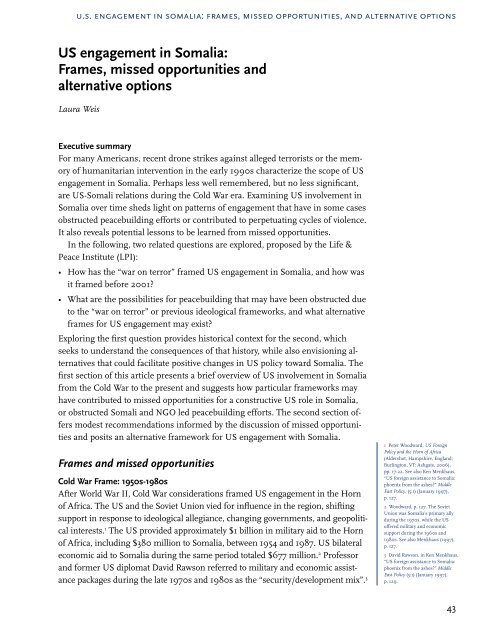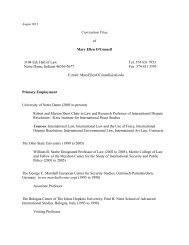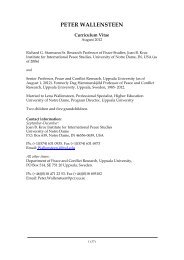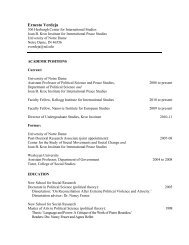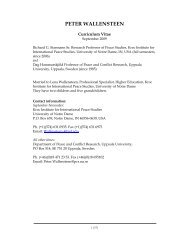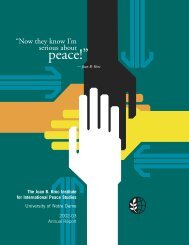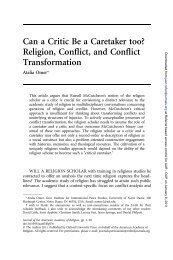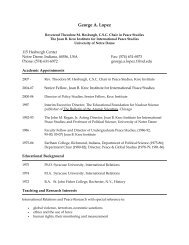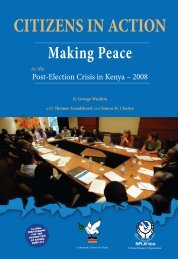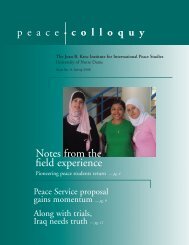Somalia: Creating Space for Fresh Approaches to Peacebuilding
Somalia: Creating Space for Fresh Approaches to Peacebuilding
Somalia: Creating Space for Fresh Approaches to Peacebuilding
You also want an ePaper? Increase the reach of your titles
YUMPU automatically turns print PDFs into web optimized ePapers that Google loves.
u.s. engagement in somalia: frames, missed opportunities, and alternative options<br />
US engagement in <strong>Somalia</strong>:<br />
Frames, missed opportunities and<br />
alternative options<br />
Laura Weis<br />
Executive summary<br />
For many Americans, recent drone strikes against alleged terrorists or the memory<br />
of humanitarian intervention in the early 1990s characterize the scope of US<br />
engagement in <strong>Somalia</strong>. Perhaps less well remembered, but no less significant,<br />
are US-Somali relations during the Cold War era. Examining US involvement in<br />
<strong>Somalia</strong> over time sheds light on patterns of engagement that have in some cases<br />
obstructed peacebuilding ef<strong>for</strong>ts or contributed <strong>to</strong> perpetuating cycles of violence.<br />
It also reveals potential lessons <strong>to</strong> be learned from missed opportunities.<br />
In the following, two related questions are explored, proposed by the Life &<br />
Peace Institute (LPI):<br />
• How has the “war on terror” framed US engagement in <strong>Somalia</strong>, and how was<br />
it framed be<strong>for</strong>e 2001?<br />
• What are the possibilities <strong>for</strong> peacebuilding that may have been obstructed due<br />
<strong>to</strong> the “war on terror” or previous ideological frameworks, and what alternative<br />
frames <strong>for</strong> US engagement may exist?<br />
Exploring the first question provides his<strong>to</strong>rical context <strong>for</strong> the second, which<br />
seeks <strong>to</strong> understand the consequences of that his<strong>to</strong>ry, while also envisioning alternatives<br />
that could facilitate positive changes in US policy <strong>to</strong>ward <strong>Somalia</strong>. The<br />
first section of this article presents a brief overview of US involvement in <strong>Somalia</strong><br />
from the Cold War <strong>to</strong> the present and suggests how particular frameworks may<br />
have contributed <strong>to</strong> missed opportunities <strong>for</strong> a constructive US role in <strong>Somalia</strong>,<br />
or obstructed Somali and NGO led peacebuilding ef<strong>for</strong>ts. The second section offers<br />
modest recommendations in<strong>for</strong>med by the discussion of missed opportunities<br />
and posits an alternative framework <strong>for</strong> US engagement with <strong>Somalia</strong>.<br />
Frames and missed opportunities<br />
Cold War Frame: 1950s-1980s<br />
After World War II, Cold War considerations framed US engagement in the Horn<br />
of Africa. The US and the Soviet Union vied <strong>for</strong> influence in the region, shifting<br />
support in response <strong>to</strong> ideological allegiance, changing governments, and geopolitical<br />
interests. 1 The US provided approximately $1 billion in military aid <strong>to</strong> the Horn<br />
of Africa, including $380 million <strong>to</strong> <strong>Somalia</strong>, between 1954 and 1987. US bilateral<br />
economic aid <strong>to</strong> <strong>Somalia</strong> during the same period <strong>to</strong>taled $677 million. 2 Professor<br />
and <strong>for</strong>mer US diplomat David Rawson referred <strong>to</strong> military and economic assistance<br />
packages during the late 1970s and 1980s as the “security/development mix”. 3<br />
1 Peter Woodward, US Foreign<br />
Policy and the Horn of Africa<br />
(Aldershot, Hampshire, England;<br />
Burling<strong>to</strong>n, VT: Ashgate, 2006),<br />
pp. 17-22. See also Ken Menkhaus,<br />
“US <strong>for</strong>eign assistance <strong>to</strong> <strong>Somalia</strong>:<br />
phoenix from the ashes?” Middle<br />
East Policy, (5:1) (January 1997),<br />
p. 127.<br />
2 Woodward, p. 127. The Soviet<br />
Union was <strong>Somalia</strong>’s primary ally<br />
during the 1970s, while the US<br />
offered military and economic<br />
support during the 1960s and<br />
1980s. See also Menkhaus (1997),<br />
p. 127.<br />
3 David Rawson, in Ken Menkhaus,<br />
“US <strong>for</strong>eign assistance <strong>to</strong> <strong>Somalia</strong>:<br />
phoenix from the ashes?” Middle<br />
East Policy (5:1) (January 1997),<br />
p. 129.<br />
43


